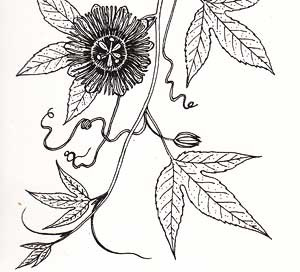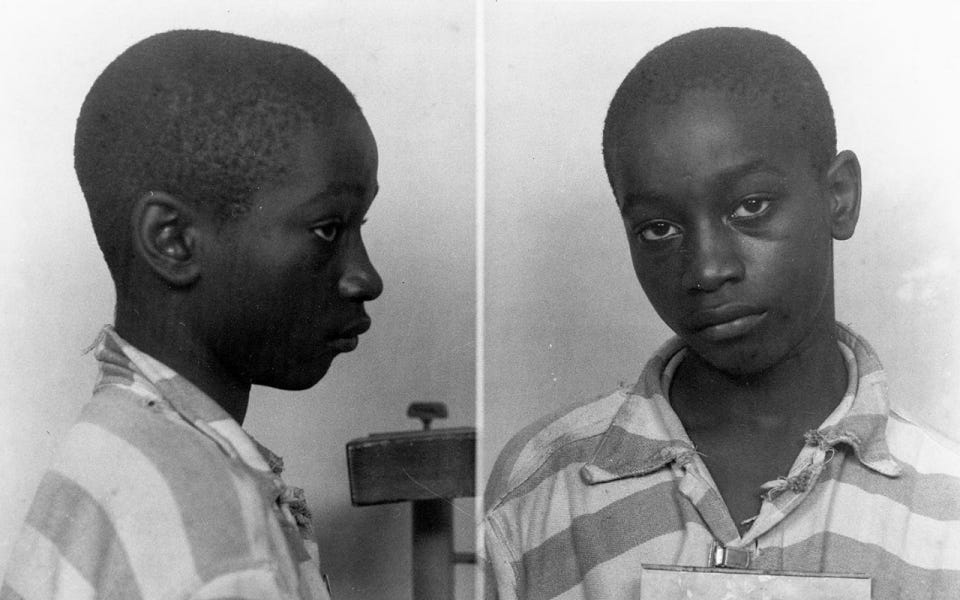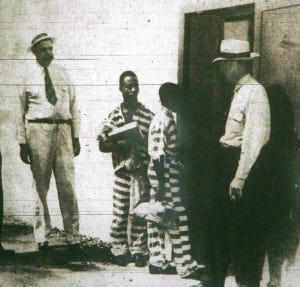Passiflora incarnate, or Maypop, is a commonly known wildflower in the mill town Alcolu, located in South Carolina. It’s a very beautiful flower. Yet it has medicinal uses, such as treating nervous anxiety and insomnia. But, here, the main interest of the flower is its natural beauty. In a small town, one dies for a little aesthetic attention to a flower growing wild in its area. On March 23, 1944, Betty June Binnicker, age 11, and her best friend, Mary Emma Thames, age 8, went off looking for the Maypop flower on their bikes. As they passed the property of the Stinney family, they asked young George Stinney and his sister, Katherine, if they knew where to search for Maypops. History doesn’t know the answer to their question, but the two little girls disappeared and were found in a ditch filled with muddy water the following day. Both were dead, and both had suffered severe head wounds.
The young African-American teenager, George, whom the two little girls asked about the flowers before their death, was arrested on suspicion of murdering the two girls. The only thing connecting the 14-year-old boy to the murder was that he talked to the girls, and due to that fact if even that is true, is the testimony of three police officers. Who, it seems, testified at the adolescent boy’s trial that lasted barely two hours.
With respect to young George’s immediate arrest, his parents were given the choice of leaving the town or getting lynched. George’s family was forced to flee, leaving their young son without support during his trial and execution. No physical evidence was brought up in the trial, and the police officers and the jury were all white, which was perfectly normal for a segregated community. The entire trial, including selecting the jury, took one day. George’s court-appointed defense counsel was a tax commissioner who, at the time, was campaigning for election to a political office in that town. The only people who testified at the trial besides the three police officers were the man who discovered the two bodies in the muddy ditch and the two doctors who performed the post-mortem examination. The police claimed that George confessed to the crime, but he claimed that wasn’t true, and there was nothing on paper or a signed confession presented to the court. The lawyer for George did not contest or question any of the case's witnesses. The entire trial, from start to finish, took two and a half hours. The jury spent ten minutes deliberating, returning a guilty verdict.
George Stinney’s execution occurred on June 16, 1944, in Columbia, South Carolina. Ironically, Columbia is known by its citizens as “The City of Dreams.” George, at the age of 14, was led into the execution chamber with a Bible under his arm. Due to his size, they had to use that Bible as a booster seat on the electric chair. At the time of his death, he was 5 feet 2 inches tall and weighed 90 pounds. Technically his size was too small for the electric chair, so the authorities had difficulty strapping him to the chair. Also difficulty in fitting the face-mask as well. The mask kept falling off his face, revealing his wide-open eyes and saliva coming from his opened mouth. It took two jolts of electricity before the boy died. From the time of the actual murders to George’s execution was precisely 81 days. So, in other words, just under two and a half months.
Interestingly enough, a pastor from the area named Mr. W. Wallace Fridy wrote a letter on behalf of George, and the then Governor of South Carolina, Olin D. Johston, wrote back to the pastor claiming that George raped the dead older girl, and there was no evidence of sexual play whatsoever. In other words, the letter was a complete lie. What interests me is how the whole system worked together to kill George Stinney. Hand-in-hand they all went and marched the poor young teenager to his death. I have a grainy newspaper photograph showing Stinney and another prisoner entering the death house in the state prison. Both were executed on that day.
I spent yesterday reading a biography on Bertolt Brecht and watching the 1931 film version of “The Threepenny Opera.” The film and musical expose how a system works and how each member of society plays the role that will make the machinery go into motion. Brecht saw the world as being controlled by police, gangsters, and thugs, and in turn, when there is a need, both groups will work together for their “common” good. One has to wonder why this young boy had to die and be treated in such a manner by the entire town, the whole district, and, eventually, the state of South Carolina. This trial had no claims to the truth because there was no evidence that George killed those unfortunate girls. But as a culture or a system, it was needed to have George killed in that electric chair. Even used his Bible as a prop to lift his body to the electrical wires. Time has passed, but nothing has changed. A system in place is a system that needs to be questioned.







PS - it's fascinating that the phrase "COLORED PEOPLE" is universally declared as offensive,
but the slightly similar phrase "PEOPLE OF COLOR" is more than acceptable and even celebrated
To quote Don Van Vliet...
"We're all colored, or you wouldn't be able to see anyone"
Skin color is about the stupidest aspect over which to judge someone, yet in our day and age a lot of well-meaning stupid people continue to reinforce this aspect (skin color) in a million different ways...especially white Liberals, who feel that they're obliged to rescue others. Malcolm X's statements on white Liberal are primary material
Anyway, if all the lights are turned off in a room, no one can see each other's skin color...
Things were certainly different 80 or 100 years ago, Tosh. It's almost as if there's some sort of type of "progression" or "cultural advancement" that occurs as the March of Historic Happenings commence. I'm glad you didn't make the mistake (in this piece) that most poor writers make in assessing and explaining historical racism...that is, the mistake of blaming people of our 2022 generation as being responsible for tragic racist events of the distant, murky past. All cultures and ALL people over time have experienced hatred and undeserved violence. If one doesn't understand this, then one forfeits their right to comment on specific moments history. Life is good, life is bad...let's not edited out other experiences that were experienced by experiencers